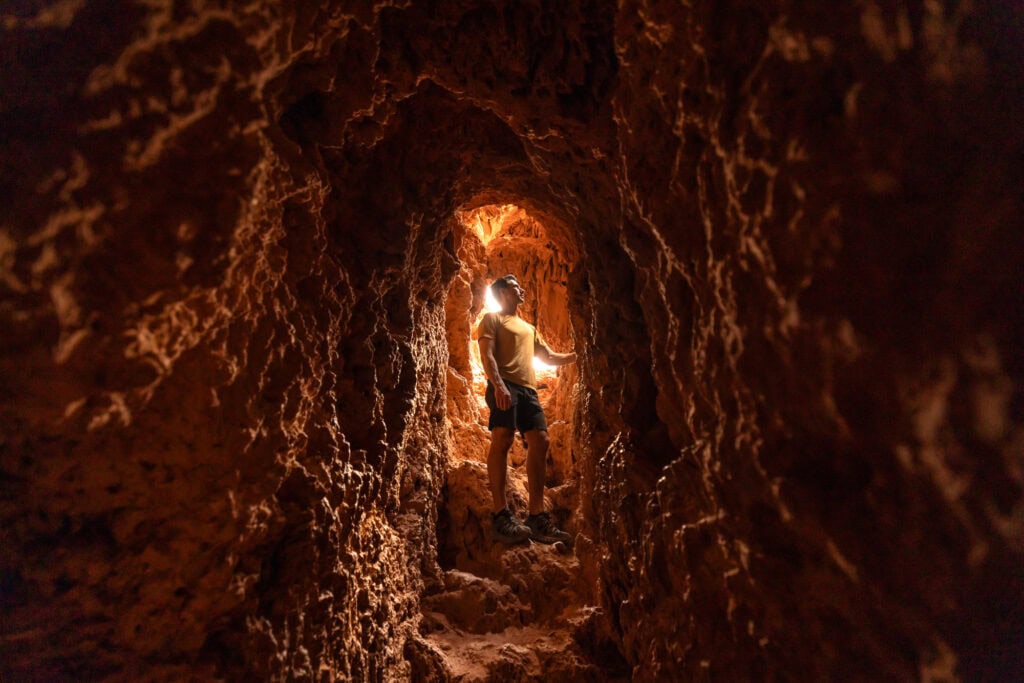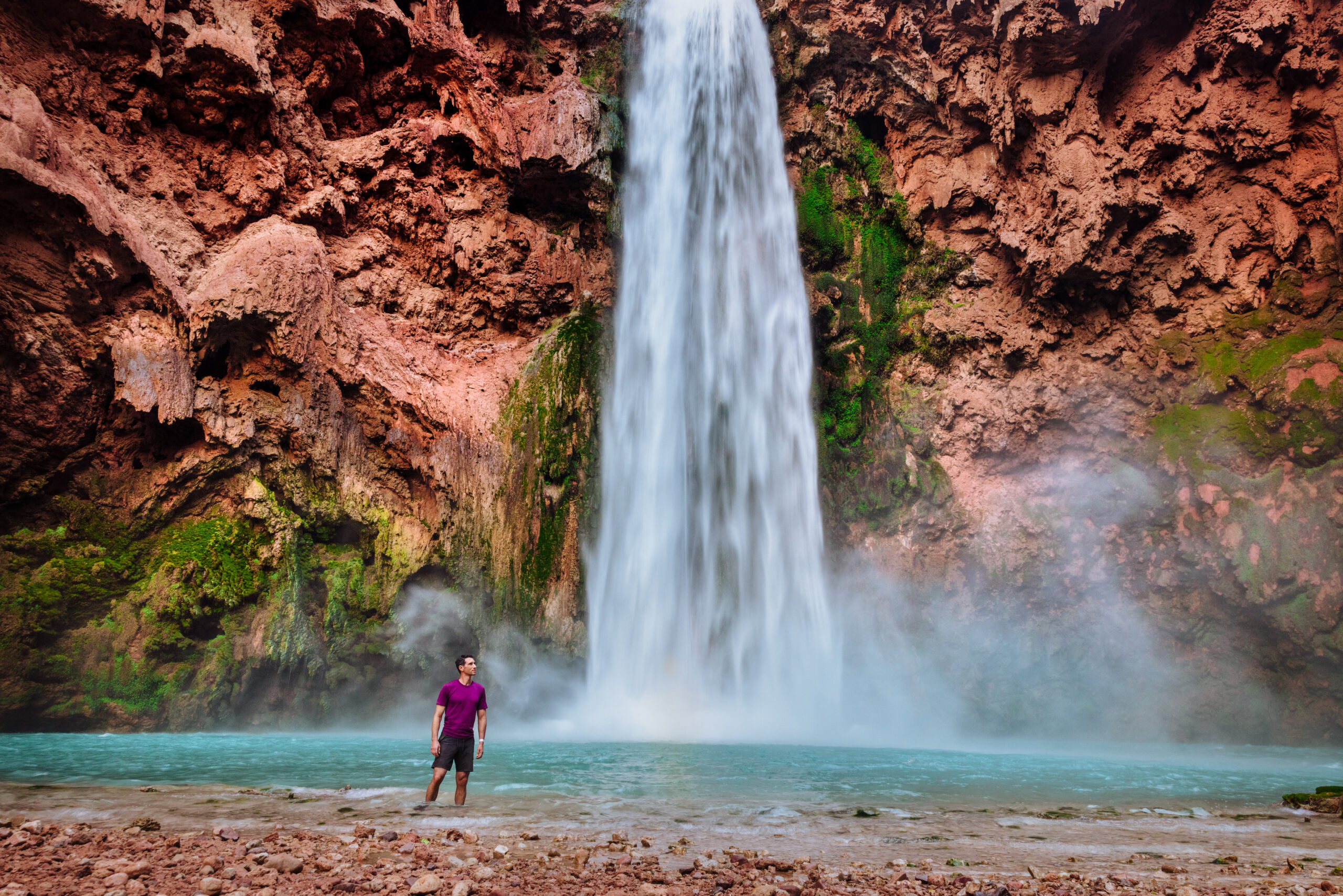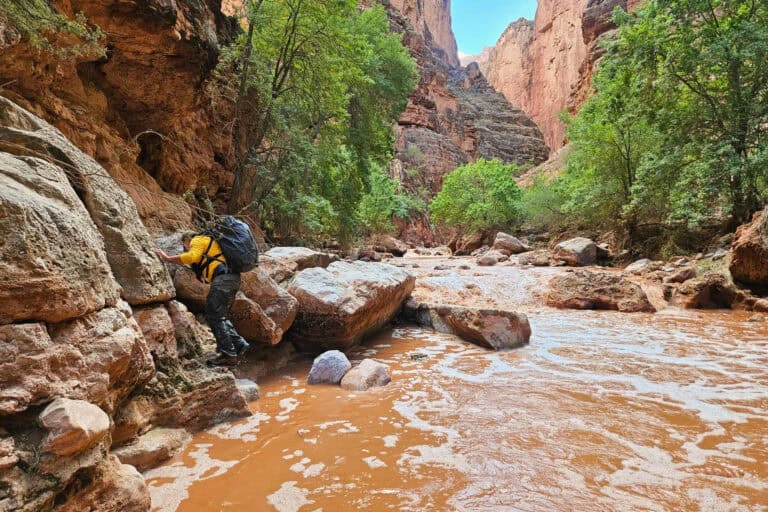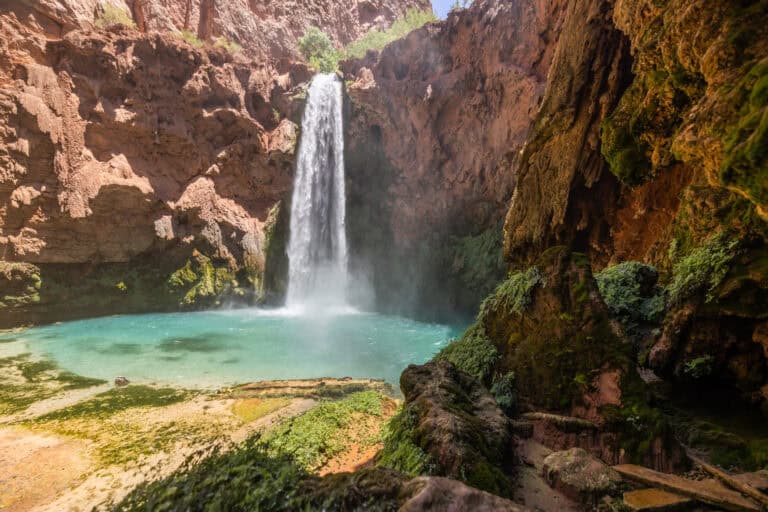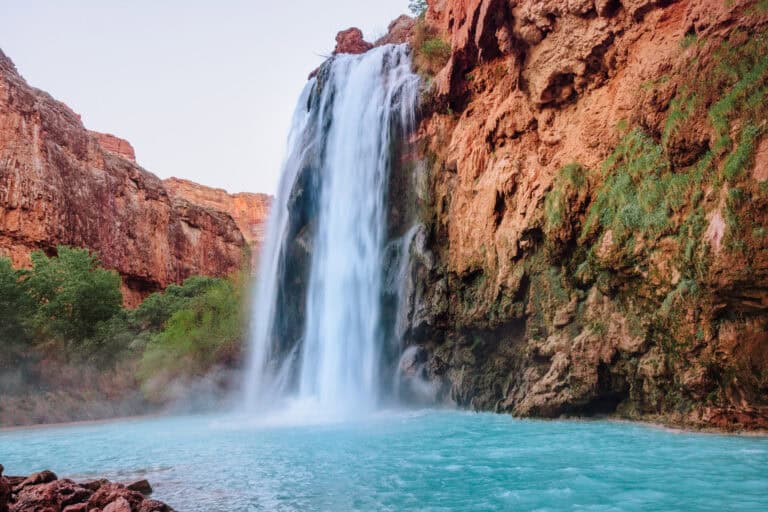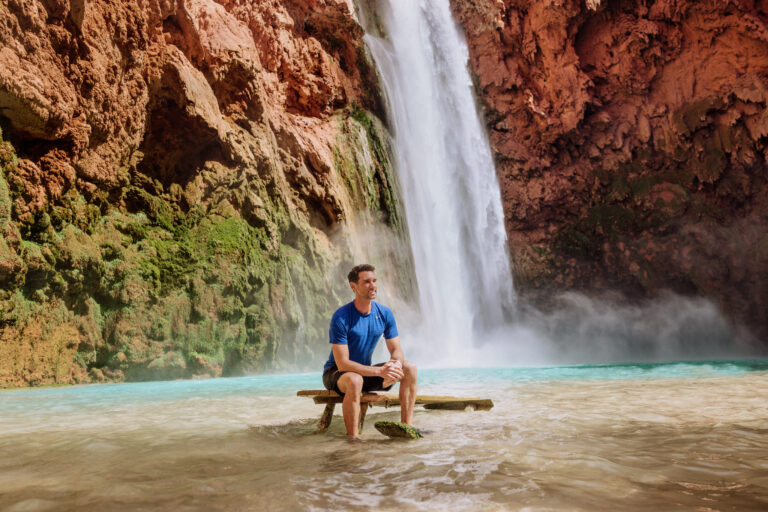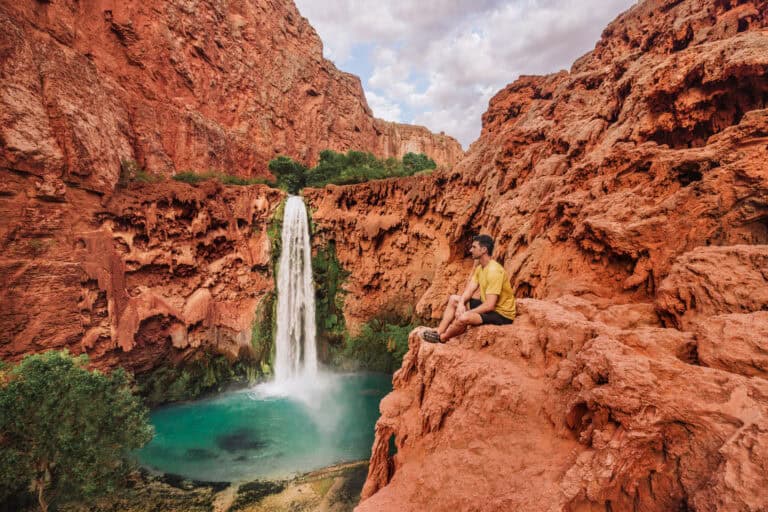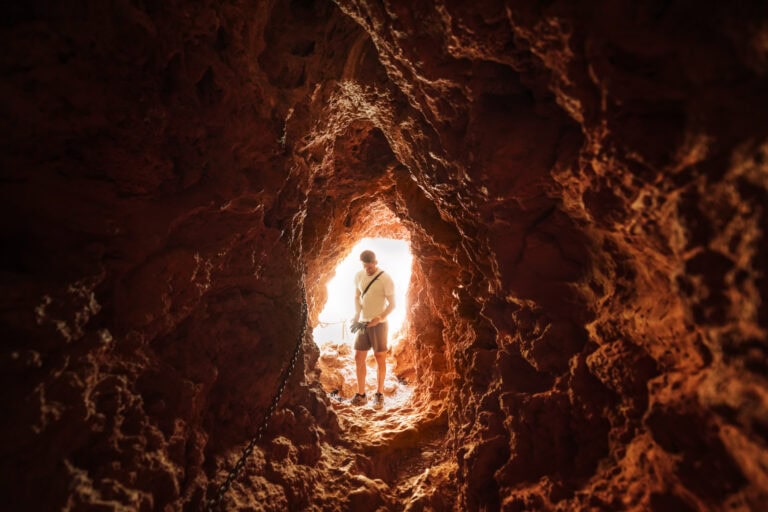Havasupai Falls in July: Prepare for Hiking & Camping in the Heat

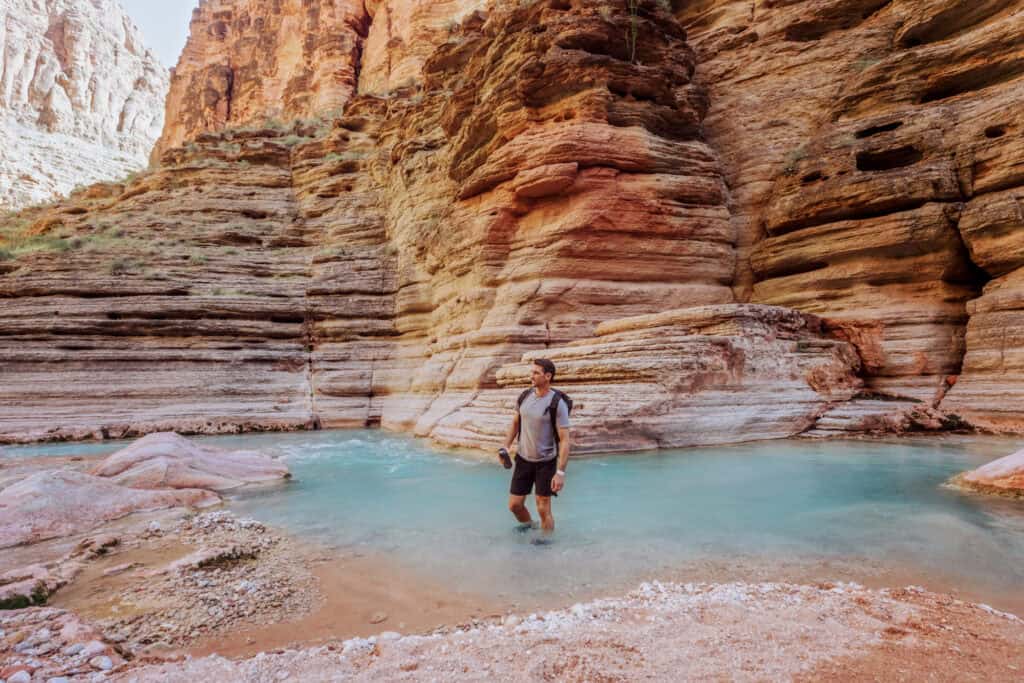
July is a hot but enjoyable time to visit Havasupai Falls, provided you are prepared for the desert heat.
By July, you need to be ready for hiking and camping in temperatures that can reach 100 degrees Fahrenheit. However, if you stay hydrated, the warm days are perfect for swimming in Havasu Creek!
Another factor to consider is the unpredictable summer monsoon season. This annual summertime weather system brings storms to Arizona, which can be severe and cause flooding. The monsoon typically lasts from late June through September.
Key Info on Havasupai Falls
- You need a permit to visit the reservation.
- Camping permits are $455, per person (4 days/3 nights).
- The Havasupai Lodge is $2277 for 3 nights (for 4 people).
- The helicopter is unpredictable, so be prepared to hike 10 miles each way.
- There are no roads, so you can’t ride an ATV or a mule.
- You pay to have a mule haul your tent and backpacks in.
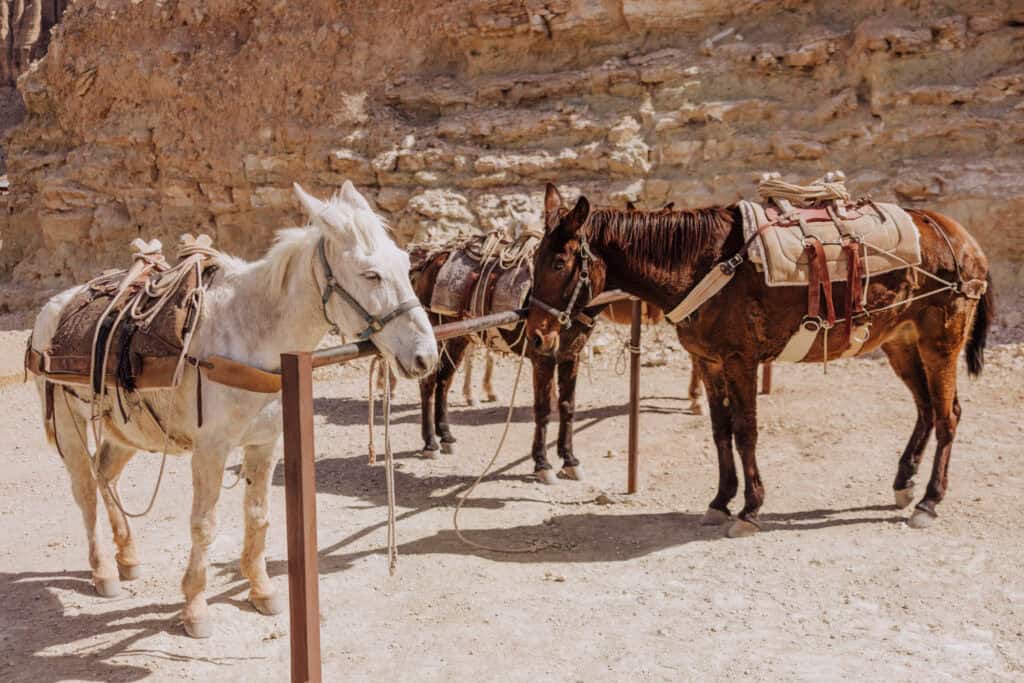
July Weather Overview
In July, expect daily highs around 100, with overnight lows in the 70s. There’s plenty of shade, and Havasu Creek will help you cool off. But you cannot underestimate the impact the heat will have on your body.
On hot days, the rock walls of the canyon seem to absorb heat, and then radiate it at night on the campsites.
- Average High: 100°F
- Average Low: 72°F
- Rainfall: Monsoon season, so potentially brief, heavy rain storms.
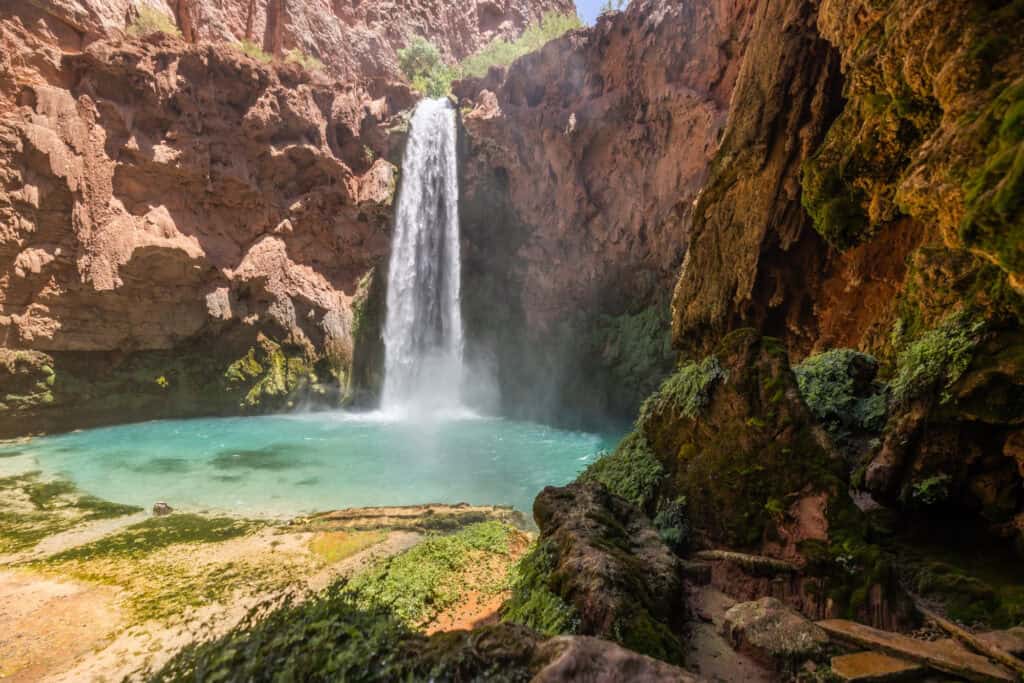
Weather Warnings
I live in Phoenix, so I’m accustomed to the summer heat.
However, during a trip to Havasupai Falls in June, in weather similar to what you’ll find in July, I experienced heat exhaustion.
On the third day of our hike, despite drinking gallons of water, I nearly passed out in the tent before sunset. Hours later, I managed to get help to reach the creek, where I submerged myself for two hours to lower my body temperature. The next morning, I felt slightly better.
On our way out, we learned that many others had suffered even worse heat-related issues and required medical evacuation. I don’t want to scare you away from visiting in June, but I hope my experience encourages you to drink more water than you think you’ll need and to take breaks to cool down throughout your hike!
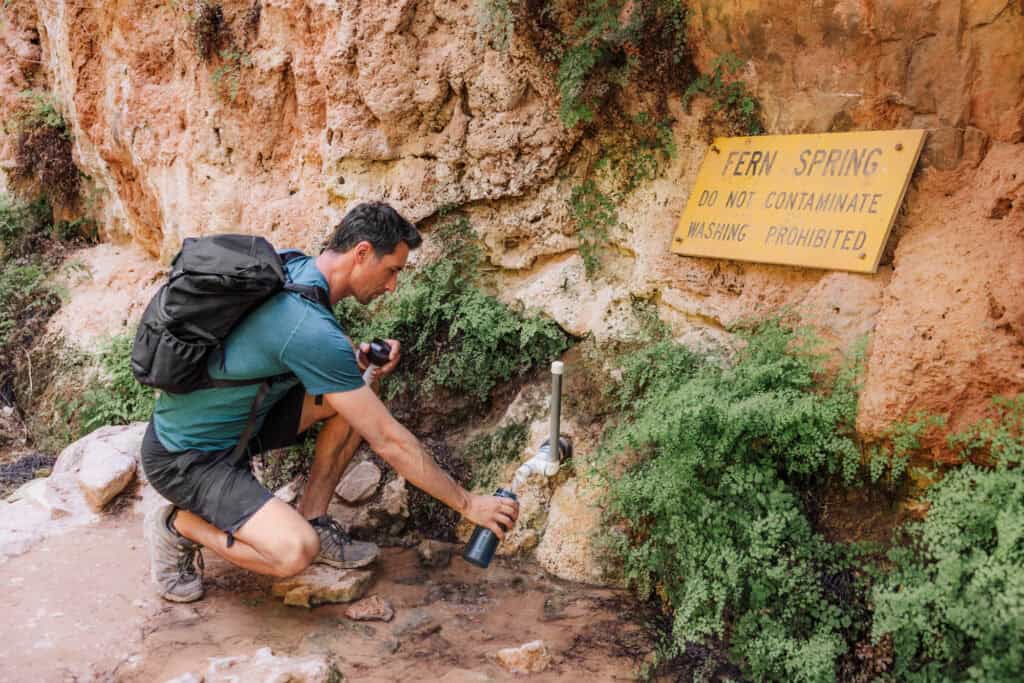
Daylight Hours
Daylight hours are lengthy in July, to around 14-15 hours of sunlight per day.
- Sunrise: : 5:30 AM
- Sunset: 8:15 PM
Even in the heat, the longer days will make hiking possible all the way to the Confluence with the Colorado River in the Grand Canyon.
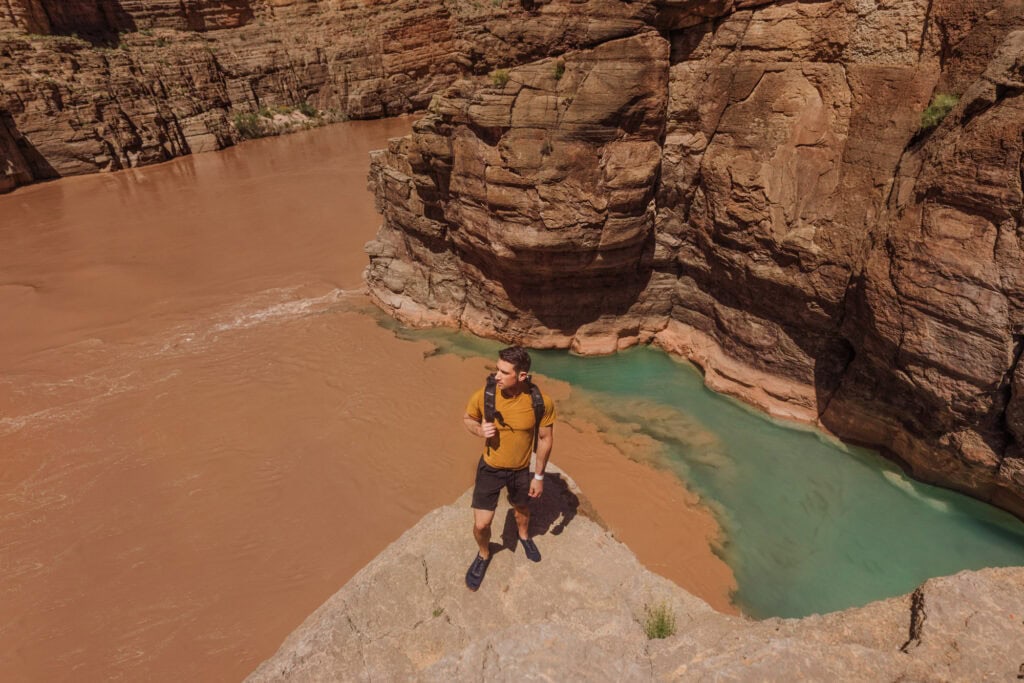
Crowds and Permit Availability
It can be difficult to secure a permit to Havasupai Falls any month of the year, and it’s the same in July.
My advice, which I’ve followed several times myself, is to keep checking the Tribe’s “Transfer” website. It’s the only place to buy permits from other people who no longer want them.
As for crowd size, Havasupai Tribe doesn’t release exact numbers, but public filings online with the Bureau of Indian Affairs and other agencies provide some insight.
The tribe grants roughly 100 permits per day. Up to 30,000 people visit Havasupai Falls each year. The campground is almost always buzzing with new people arriving and other groups packing up to leave.
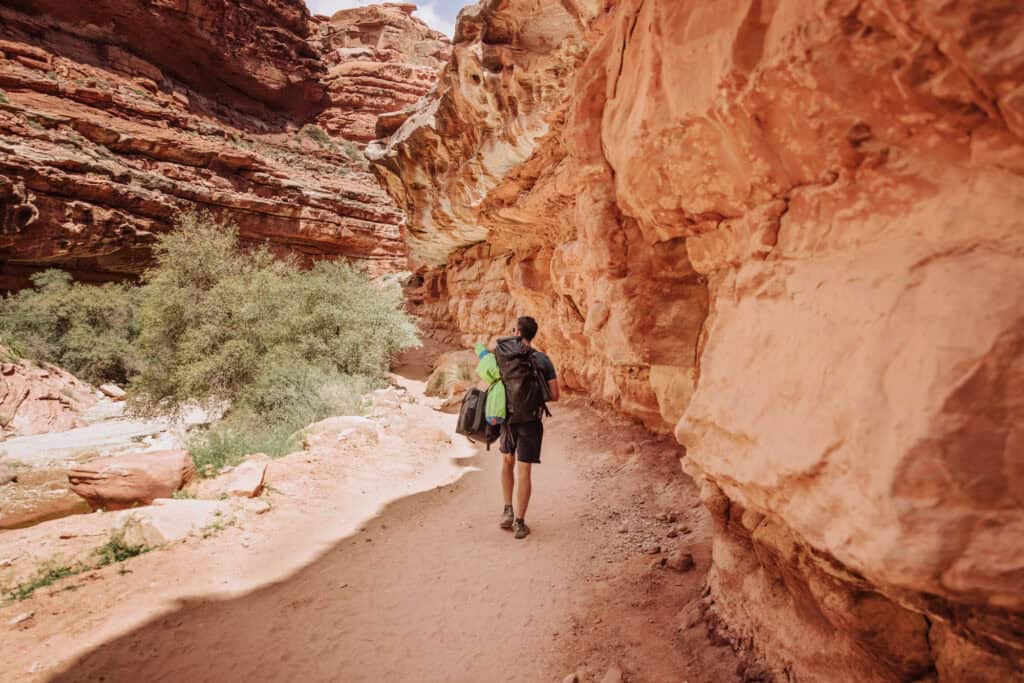
Hiking to Havasupai Falls in July
In the spring, and even throughout much of May, the temperatures are cool enough to start your hike to Havasupai Falls at any time of day. However, in July, you should almost certainly begin your hike before dawn from the Hualapai Hilltop parking area.
We started at 4:00 AM, wearing headlamps, and were happy we made it to the village of Supai by 8:00 AM!
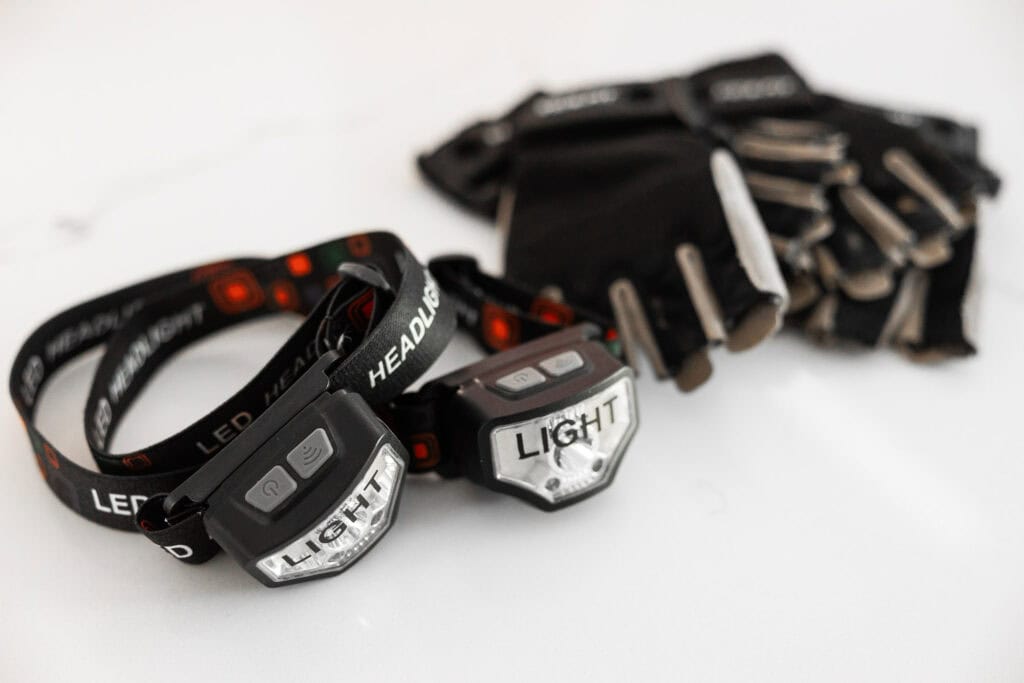
Depending on your pace and the number of stops you make to rest, the hike will take approximately five hours. While there are shady spots along the trail, it’s best to avoid hiking in the heat of midday.
Please keep in mind that the Havasupai Tribe often enforces a rule requiring all hikers to depart the trailhead by 2:00 PM. Because of this, evening or sunset hikes are not always permitted. Therefore, starting your hike before dawn is the best option in July.
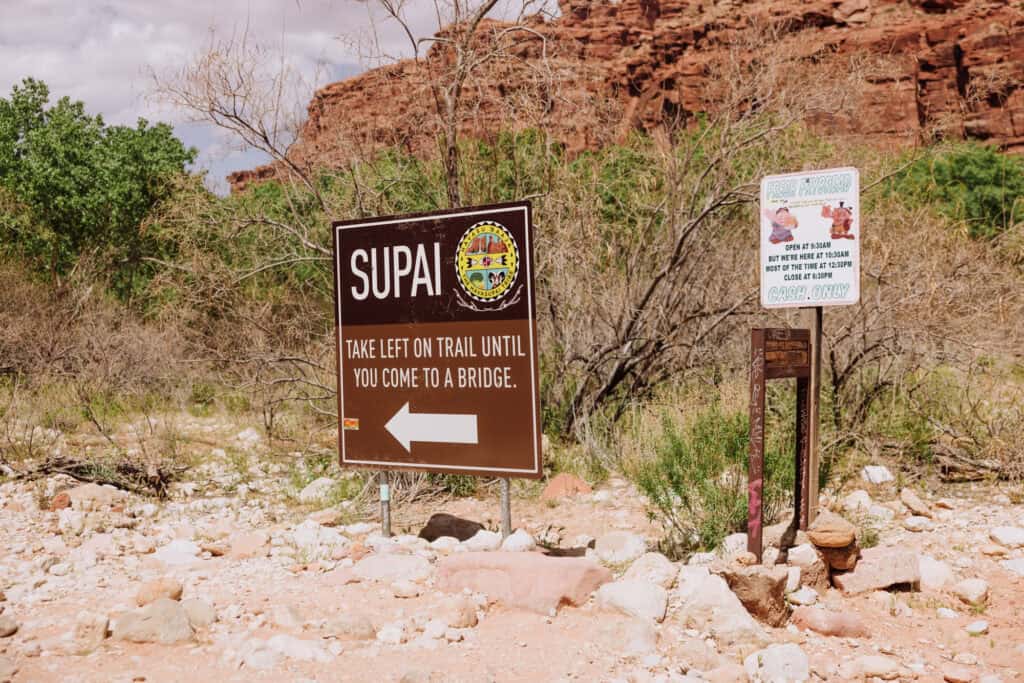
Trail Conditions and Challenges
Storms likely won’t impact the trail conditions in July. You should find the route clearly marked and easy to follow.
The water sources along the lengthy canyon stretch of the trail are minimal. Be prepared to carry enough water to last you about 7 miles until you can fill up your filtered container with creek water.
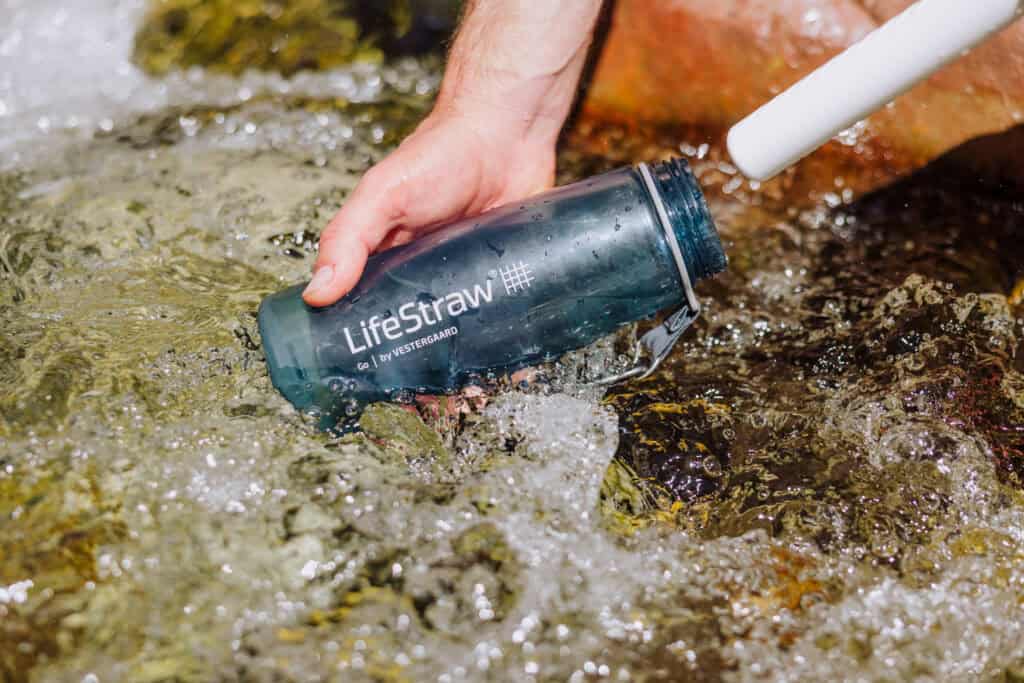
Camping Along Havasu Creek in July
In July, you have to be prepared for warm nights while you camp along Havasu Creek.
You’ll find campsites on both sides of a one-mile stretch of the creek, between Havasu and Mooney Falls.
Campground Conditions and Best Spots
In July and throughout the summer into September, there is always a small risk of flooding due to monsoon rainfall from the plateau above the canyon. Over the years, campers have had to evacuate to higher ground, leaving their campsites behind when the waters rise.
This is a photo of Beaver Falls during a flood in 2024.
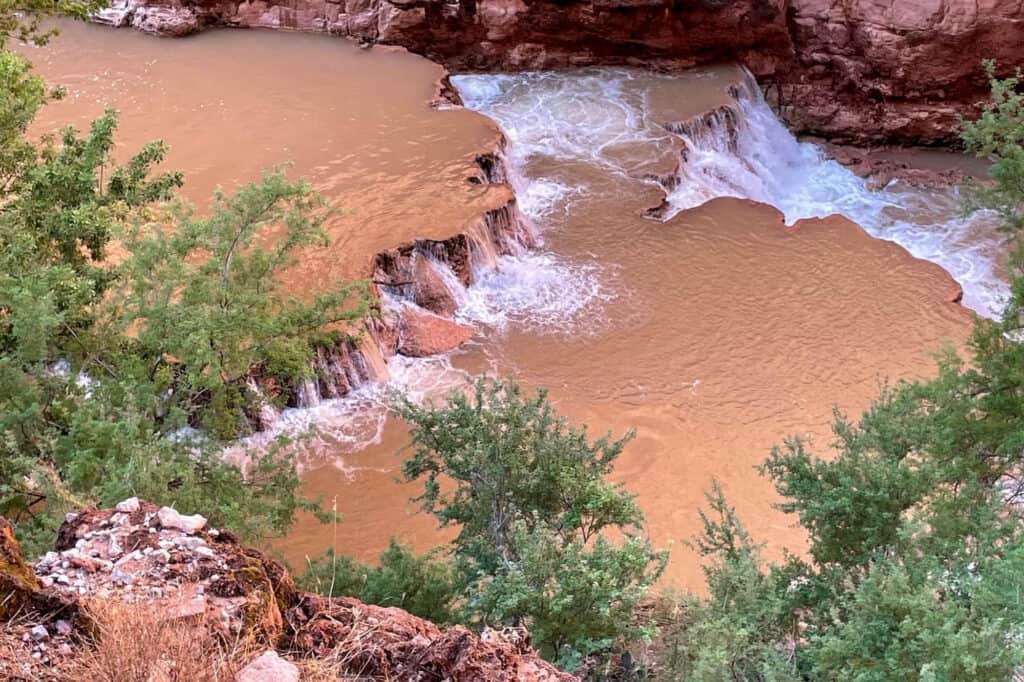
My advice for the best camping spots in July remains consistent with any other time of year. When you arrive at the campground, head towards Mooney Falls and look for a campsite along the beautiful blue creek. As always, choose a site that is away from the vault toilets, as the odor can become particularly unpleasant during the summer.
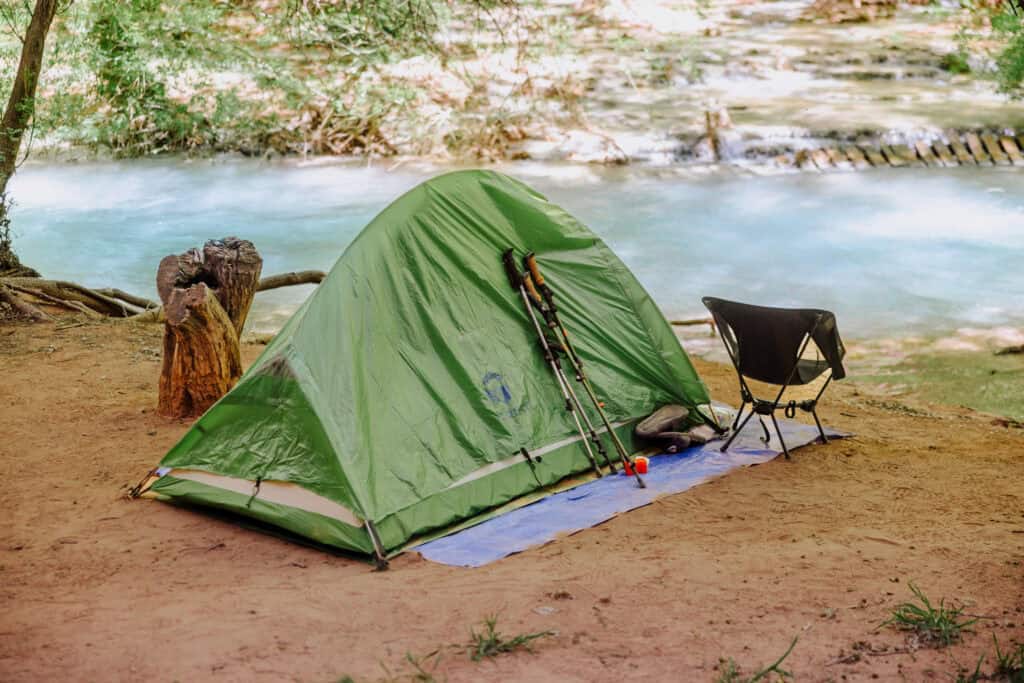
Nighttime Temperatures and Sleeping Tips
Nighttime temperatures in July are warm, so it’s important to consider this when selecting a sleeping bag and tent. Many people opt to sleep in hammocks instead of tents during the summer at Havasupai Falls.
The next time I go camping in June or July, I might not even bring a sleeping bag. It might be more practical to bring a sheet to use over my sleeping pad instead of a sleeping bag.
Wildlife and Bugs to Watch For
I’ve never experienced any issues with bugs, flies, or mosquitoes, but I know that others have. For this reason, I usually carry a small bottle of insect repellent just in case.
When it comes to squirrels and other scavengers at the campsite, their presence can vary. Occasionally, you might find evidence of a mischievous rodent getting into someone’s food. Personally, I’ve always managed to keep our food secure in airtight bags and containers, but many people choose to bring rat sacks as an extra precaution.
As for wildlife, you’re more likely to encounter frogs and lizards near the creek, which is to be expected.
If you’re looking for an exciting wildlife encounter, you’re sure to see desert longhorn sheep on the trail between Mooney and Beaver Falls.
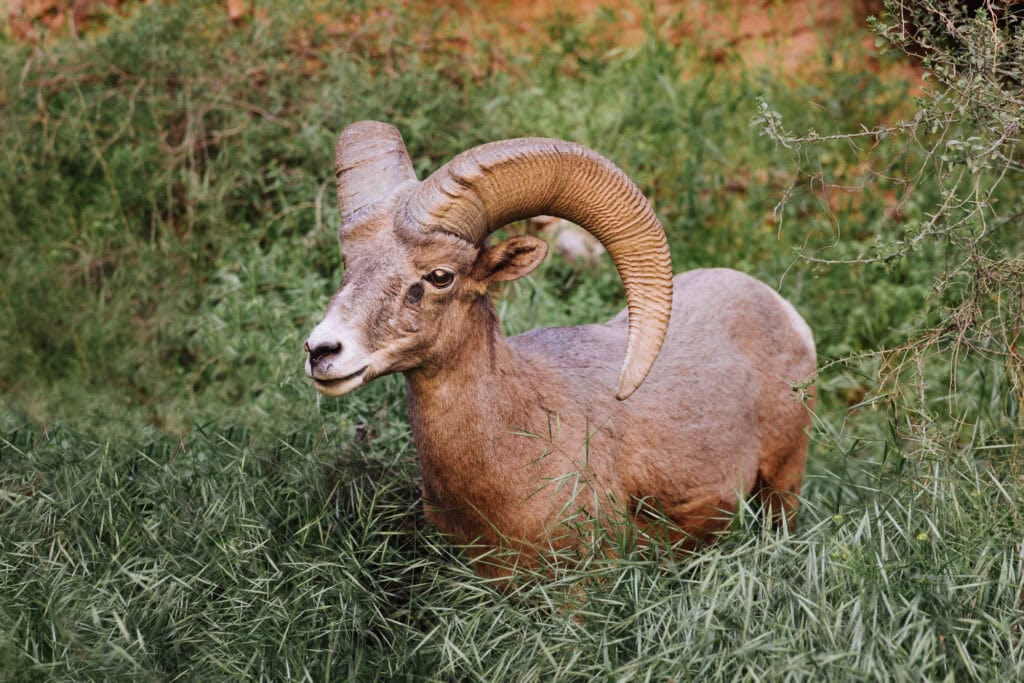
Waterfalls and Swimming in July
Most months, there’s a chance that a storm will turn the blue creek water brown for a few days. That holds true in July, too, as the monsoon sends storms into Arizona. Usually, if a storm moves through and muddies the creek, it’ll clear up in two days. Most days will be totally dry, but it’s important to know about the monsoon risk.
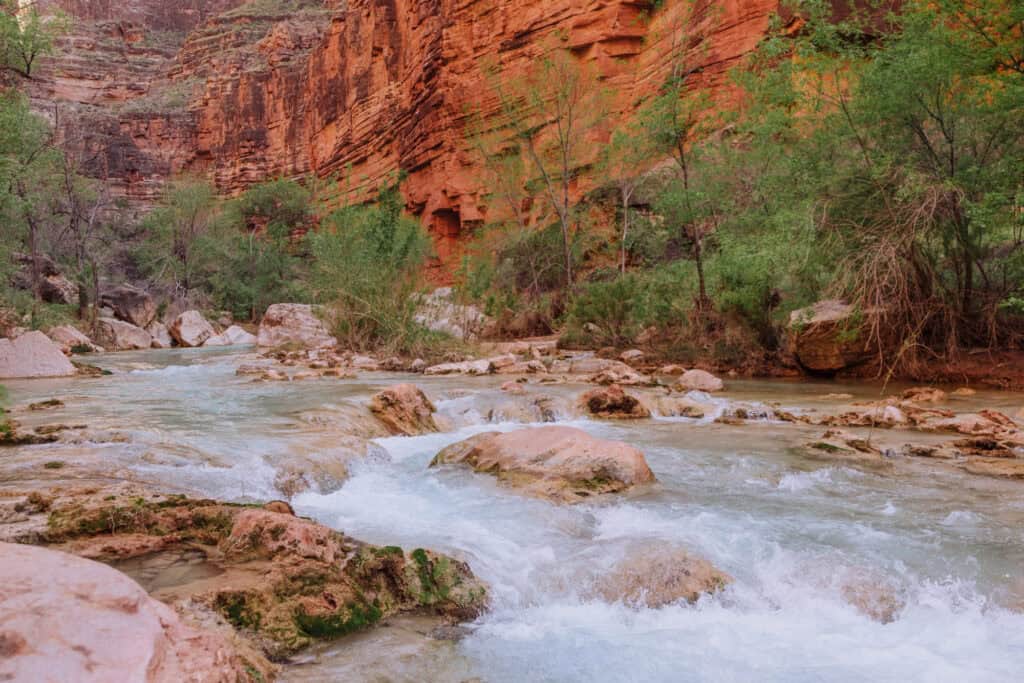
Water Temperature
Here’s a chart of the water temperatures in Havasu Creek over the month of July in 2024. Temperatures vary through the day, but the water is usually between 75 and 78 degrees. It’s great for swimming and cooling off!
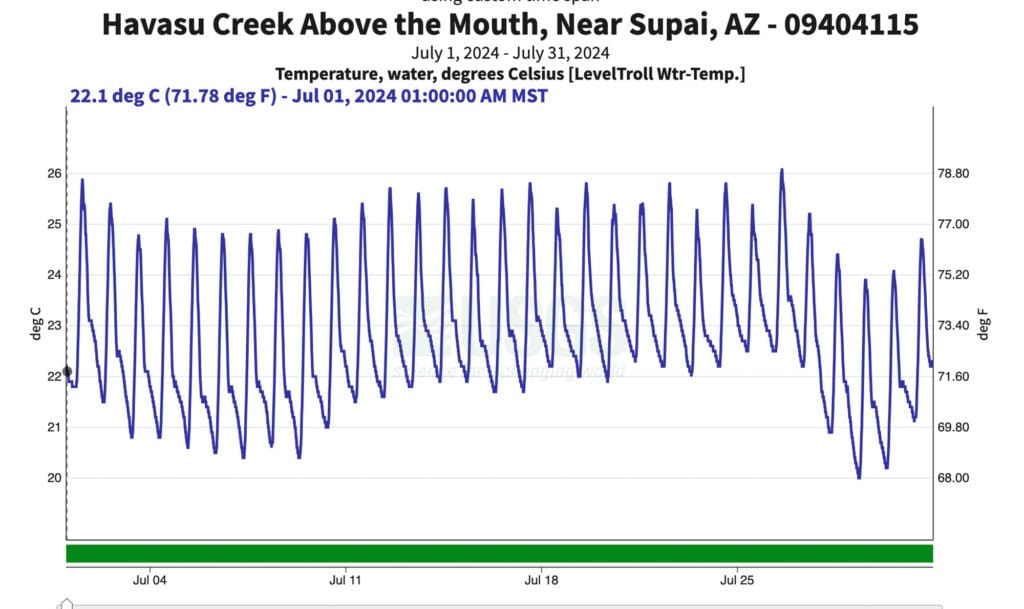
Packing List for Havasupai Falls in July
My general advice for packing is: Don’t *over* pack, especially if you’re carrying everything in on your back.
Remember: it’ll be hot in July, so you don’t need long sleeves or pants, unless you’re wearing pants to prevent pricks from the shrubs along the trail between Mooney and Beaver Falls.
camping gear
🔘 Lightweight Tent
🔘 Or Hammock w/ Bug Net
🔘 Sleeping Bag or Blanket
🔘 Sleeping Pad
🔘 Headlamp (with red light)
🔘 Water Filter/Bladder
🔘 Inflatable Pillow
🔘 Packing Cubes
🔘 Folding Table
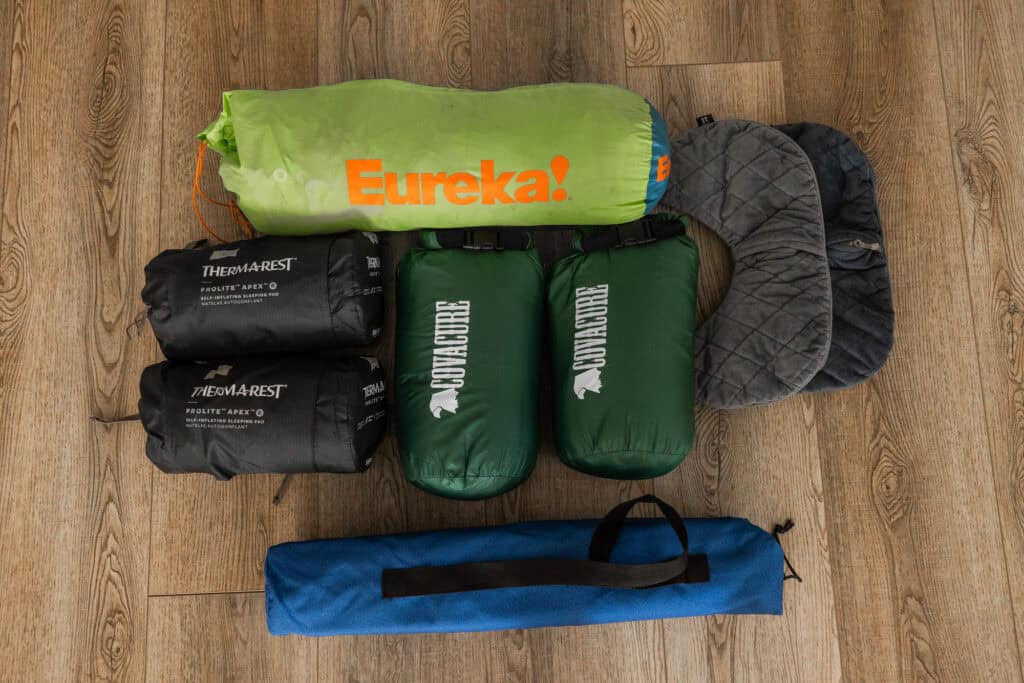
Hiking Gear
🔘 Hiking Shoes
🔘 Foot Glide
🔘 Backpack
🔘 Smaller Day Pack
🔘 Hiking Socks
🔘 Sock Liners
🔘 LifeStraw Filter & Bottle
🔘 Trekking Poles
Hygiene & Toiletries
🔘 Deodorant
🔘 Eco-friendly Soap
🔘 Toothbrush & Toothpaste
🔘 SPF
🔘 Bug Repellent
🔘 Toilet Paper (half a roll)
🔘 Dry Bag
🔘 First Aid Kit
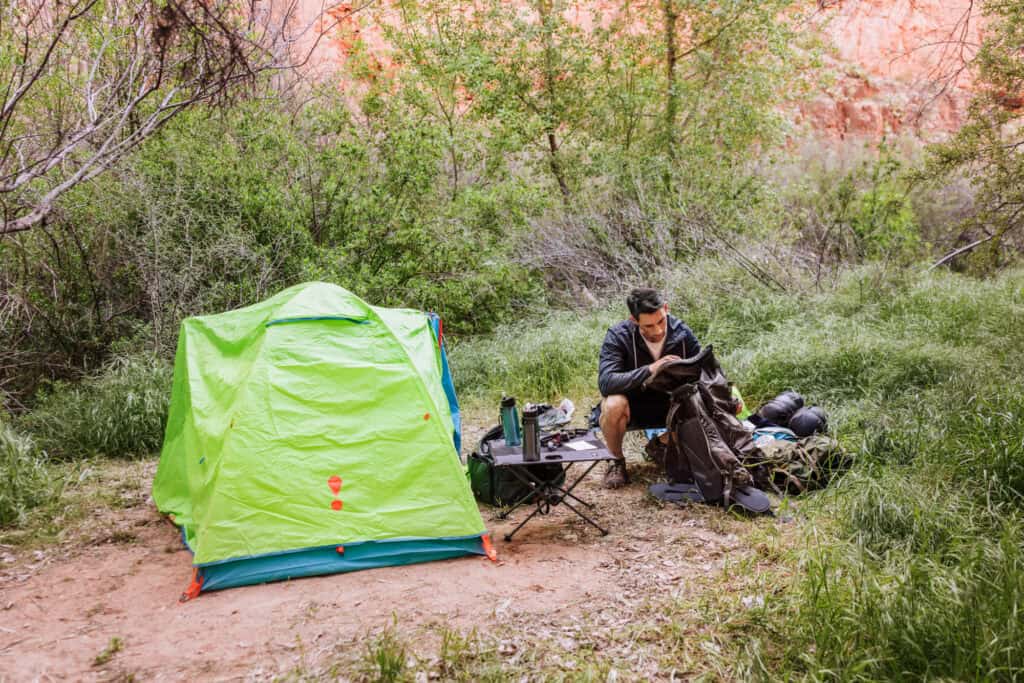
Food & Cooking
🔘Jetboil & Propane
🔘 Matches or Lighter
🔘 Freeze-Dried Meals
🔘 Nuts & Protein Bars
🔘 Utensils
🔘 Foldable Cups, & Bowls
🔘 Electrolyte tabs or packets
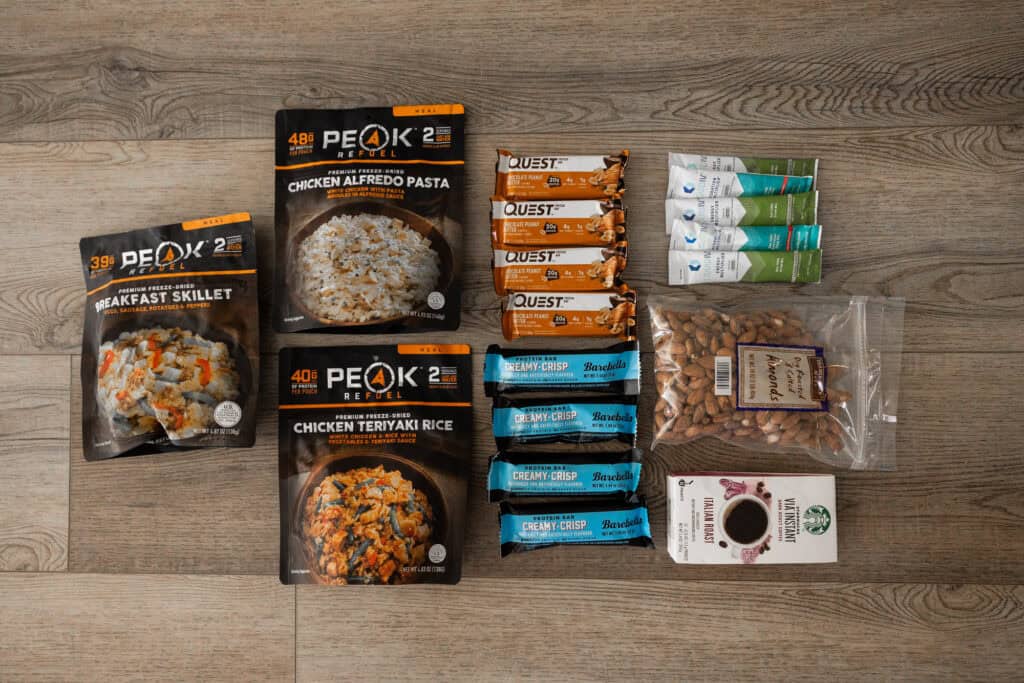
Miscellaneous
🔘 Cash (for tacos and things in Supai)
🔘 Battery Packs (2 minimum)
🔘 Quick Dry Towel
🔘 Gloves (for climbing Mooney Falls)
🔘 Rope (optional)
🔘 Rain Poncho (optional)
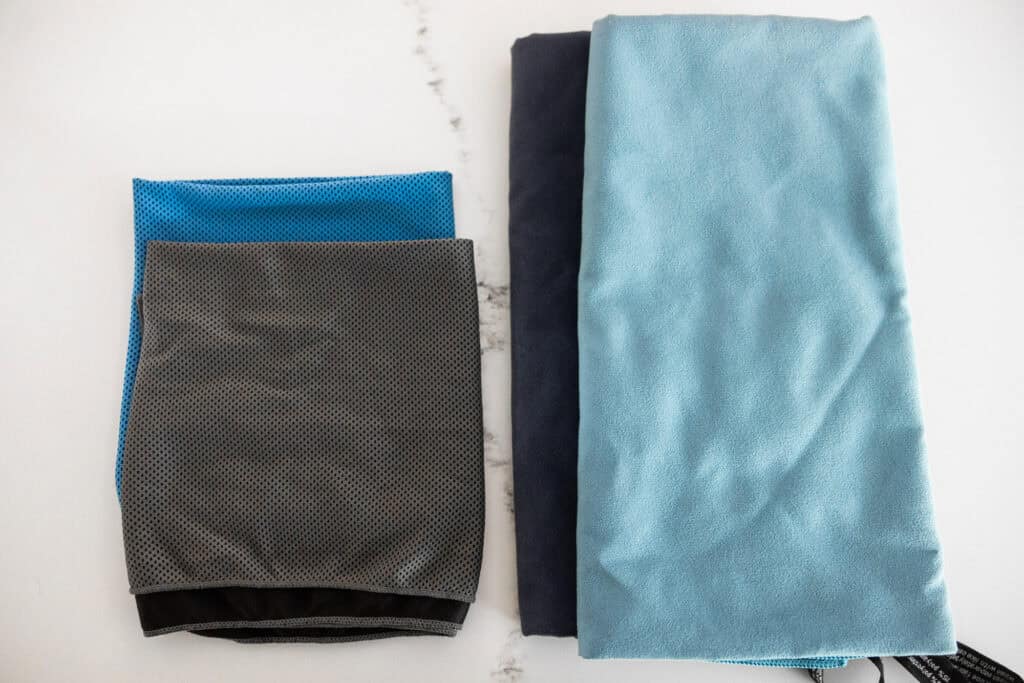
Leave in Your Car
🔘 Water
🔘 Sports Drinks
🔘 Food
🔘 Clean Clothing
🔘 Sneakers

Wrap: Pros and Cons of Visiting Havasupai in July
In July, you have to be ready for the heat at Havasupai Falls! It’s not a reason to avoid going. You just have to be prepared mentally and physically.
Advantages of This Time of Year
Temperatures in July will be hot, so there’s no need to pack extra clothing or layers to sleep in. The longer daylight hours in the summer months provide more flexibility for your days at Havasupai Falls.
Additionally, if you plan to hike all the way to the confluence with the Colorado River, you’ll appreciate the extra daylight to ensure you can return to your campsite before dark!
Potential Drawbacks to Consider
Hiking in the heat can be challenging, so it’s important to plan your treks to avoid being on the trail during the hottest parts of the day.
Additionally, July brings a risk of unpredictable monsoon storms. If you secure your permits for July, approach your hikes with a positive mindset and focus on staying hydrated by drinking plenty of water!
